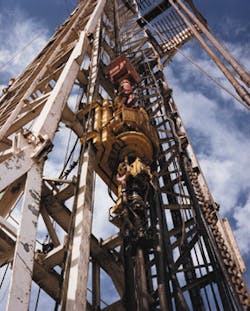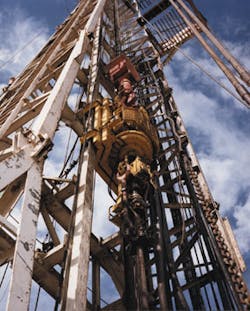Technology driving, preserving industry recovery
Rick Von Flatern
Technology Editor
The topdrive drilling motor was a leading influence towards a more efficient petroleum industry.In the early 1990s, oilfield service companies confined R&D activities to projects with a definable market. At the same time, operators ended a frenzy of cost- and personnel-cutting to search for technological props for their sagging bottom lines. The result has been a technology-driven turnaround that has left the industry pleasantly stunned.
At the head of the new technology parade, by virtue of its impact on industry fortunes, is 3D seismic data processing and management. Operators have used it to find more new hydrocarbon deposits for less by cutting the odds of success from one in ten to nearly one in two. It has also honed well placement to such accuracy that mature fields can be rejuvenated with wellbores drilled into hydrocarbons missed on original surveys, but spotted on new 3D survey.
Improvements to 3D include shortening cycle time to a fraction of it's original time. Also, better on-site quality control allows surveyors to avoid performing useless, time-consuming surveys that must be repeated weeks or even months later.
Innovations to 3D seismic will not end with the 20th century. Time-lapse 3D, or 4D, in which surveys are run over the same ground at different times will allow production managers to see fluid movement, flood fronts, missed hydrocarbon deposits, and infield drilling opportunities.
More wells, one location
Multilaterals wells are the latest innovation from the world of horizontal drilling. As with simple horizontal wells, they act like giant fractures draining the formation towards the main wellbore. And like their parent horizontals, they bring a nearly unlimited number of wells to a single surface facility.
But producing more hydrocarbons may be only the first multilateral application. Theoretically, they could be used to form a multi-function network, or "underground factory" wherein laterals off a single wellbore could be designed for production, separation, water and gas injection, and monitoring. Part of the necessary technology, surface controlled downhole tools, and systemization of all field functions are already the subject of service company alliances.
MWD, LWD, FEWD, SWD
Of course, no convoluted wellpaths would have been possible without some technologies brought to the marketplace since oil prices collapsed a decade ago. Top drive drilling motors, a novelty in 1990 is now a staple of any rig upgrade or newbuild. They are valued by directional drillers for their ability to rotate while coming out of the hole and to handle 90 ft sections of drill pipe. In the 21st century, top drives will send rotary tables the way of cable tools, at least offshore.
Of equal importance to the proliferation of horizontal wells has been the continuing improvement of behind-the-bit measurement tools (MWD) that communicate bit direction and location to the surface in real-time.
From those MWD tools, evolved real-time logging (LWD) tools that include resistivity, density, and neutron porosity logs. Lately, several manufacturers have overcome the obvious difficulties of placing an acoustic tool in a downhole drilling environment and developed a sonic-log-while-drilling tool. Sonic logs add to LWD a seismic correlation ability that was the last remaining advantage of wireline logs. If the technology, essentially formation evaluation while drilling (FEWD) fulfills its promise, a great many wells will be drilled in the 21st century without the expense and time of wireline logs.
At least one more major step is still to come from real-time drilling measurements. By combining ever more powerful computer processing, increasingly sophisticated FEWD, and precise bit direction control, wells will eventually be drilled using real-time seismic data from ahead of the bit (SWD).
It is not too fantastic to imagine a near-future driller in a climate-controlled room, manipulating bit direction with a joystick in response to the real-time data being transmitted to his computer screen. Using parameters programmed into a computer, the driller may even become redundant.
Ever deeper water
Deepwater and now ultra deepwater drilling activities, more than anything else will sustain the petroleum industry turnaround well into the 21st century. But deepwater (more than 2,000 ft) activities engender their own technical issues.
Among the more daunting are hydrate and paraffin subsea pipeline blockage. Generally considered little more than a nuisance in most areas, the high flow rates, remoteness, and miles of natural cold water bath through which deepwater production must pass make it quite serious for producers.
The problem is sufficiently worrisome as to rate its own committee in the joint industry organization, Deepstar, and for that consortium to commission a facility to test vendors' hydrate and paraffin remediation equipment in a simulated five-mile long blocked pipeline.
Also, a physical reality of deep water drilling are extreme riser lengths. The possible need to instantly replace the 21-in. diameter, miles-long column of riser mud means a great deal of rig variable load must be dedicated to ready drilling fluids as does several miles of riser pipe and the tensioners to handle them.
The lost circulation and extreme riser weight issues are being addressed on several fronts and will likely be largely resolved before the turn of the century. One offensive, and borrowing a page from onshore operations, Statoil will soon drill an offshore well underbalanced. Besides having implications for extended-reach drilling, an underbalanced well could conceivably be drilled with only a return line between the subsea wellhead and the rig, completely eliminating the riser.
On a second front a composite drilling riser is in testing stages and should be ready for a field run within a year. The composite riser, also a Deepstar-initiated project, will weigh a fraction of comparable steel risers.
But steel or composite, 10,000-ft waters create water current questions as yet unanswered, including possible harmonic motion and the difficulty of returning a riser to within inches of a spot two miles away through moving water.
Basic engine there
The technological innovations of the past few years were a revolution inspired by flat oil prices and an industry so lean its ribs were showing. Circumstances, everyone agrees, are better now. Massive layoffs and corporate reorganizations, once grist for the daily mill, have become rare enough to be news again.
But the basic engines of the latest forward technological movement are still in place. Oil prices will remain flat, and with expanded activity and budgets, companies are more short-handed than ever. The imperative to produce more with less was the industry dilemma in 1990 and will be in 2000. Even in a healthy commodity industry, the rule is still innovate or perish.
Copyright 1996 Offshore. All Rights Reserved.

